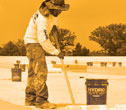In July, the Roof Coatings Manufacturers Association (RCMA) held the first International Roof Coatings Conference. The conference, co-sponsored by Oak Ridge National Laboratory, Oak Ridge, Tenn., provided some useful insights into technical research being conducted in and relating to the roof coatings industry.
Research papers
The conference consisted of 10 presentations of technical research papers and two keynote presentations. Following is a brief summary of several presentations.
Joe Rokowski, elastomeric roof coatings group leader for Dow Construction Chemicals, North America, Spring House, Pa., presented "Weathered Thermoplastic Polyolefin Roofing: Characterization, Surface Analysis and Best Practices for Coating," which discussed TPO membrane evaluation and preparation for coating applications. Because of their chemical compositions, TPO membranes are hydrophobic surfaces. A well-defined test of hydrophobicity is to measure the contact angle of a drop of liquid, typically water, placed on a substrate. A high contact angle indicates greater hydrophobicity and greater difficulty to "wet out." A low contact angle indicates a surface that is easier to wet out and, therefore, easier to coat.
The research also shows data indicating TPO membranes from different manufacturers exhibit different contact angles and the contact angles of weathered TPO membranes increased from 36 to 106 percent compared with the new membranes tested. This is a somewhat unique finding because most conventional building materials exhibit decreased contact angles with exposure. The research findings offer a plausible explanation of why it is difficult to achieve proper adhesion when field-applied coatings are used on weathered TPO membrane surfaces.
Amir Khan, vice president of Gardner-Gibson's Asphalt Division, Tampa, Fla., presented "Elastomeric Roof Coatings Post Applied Coatings as Compared to Pre-coated Membranes." The paper discusses some of the complexities of factory-coated polymer-modified bitumen cap sheets, including coating thickness, cure time, coating to fresh substrates, roll blocking and packaging related issues, and defects and imperfections.
Many field-applied coatings are applied at 1 1/2 to 2 gallons per square (100 square feet) per coat, and in some applications it is not unusual to use two coats resulting in a dry film coating thickness of about 40 mils. Most pre-coated membranes use about 0.5 to 0.8 gallons per square. Also, pre-coated membranes typically are heated in-line using infrared heaters to force drying and curing of coatings in the short time period during manufacturing.
For example, a production line manufacturing pre-coated membrane typically runs at about 120 feet per minute. A coating thickness of 0.5 to 0.8 gallons per square at 120-feet-per-minute line speed will require infrared heater output of 1,200 to 1,700 F to properly dry and cure the coating. If the coating cures too rapidly, it can become too brittle and begin to flake off the membrane. If it cures too slowly, it can result in roll pickups and sticking within rolls.
The research also presented data showing pre-coated polymer-modified bitumen products lose their reflectivity with aging at a greater rate than field-coated products. This data appears consistent with observations of new versus three-year reflectivity data from similar products listed in the Cool Roof Ratings Council's rated products directory.
Steven Heinje, technical service manager of Quest Construction Products, Phoenix, presented "Coating Forensics for Roofing," which provides guidelines for sampling, pattern recognition, field evaluation and laboratory analysis for coatings.
Proper field evaluation, including a moisture survey and test cuts; tape adhesion, peel adhesion, weight solids measurement, dry film thickness testing; exudate sampling; and close-up macro photography and microscopy can be useful when identifying many coating problems. The paper provides detailed descriptions of each of these processes and describes how an established ASTM International test method can be reversed and conducted in the field using coating samples collected from ponded water to determine empirical coating solids weight data for weathered coatings.
Useful information
The first International Roof Coatings Conference provided useful information about technical research being conducted in the U.S. roof coatings industry. For a link to copies of the individual research papers and the two keynote presentations, log on to www.roofcoatings.org.
Mark S. Graham is NRCA's associate executive director of technical services.



